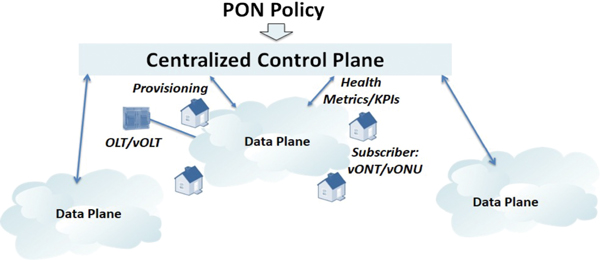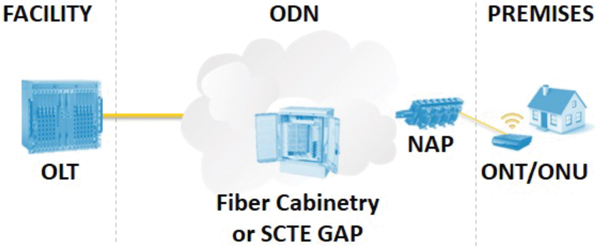Cloud-Powered PON
By Steve Harris
Unleashing the Full Potential of SDN and NFV
Today, most operators are on the path to a passive optical network (PON) deployment. Many operators are only focused on upstream and downstream bandwidth in their deployment of FTTH or migrating their old PON technologies to a new more robust PON solution. Migration is not easy, often laborious, and complicated, presenting service interruptions for subscribers. These deployments today are not rooted in automation, virtualization, cloud computing and Internet Protocol (IP). Furthermore, today’s traditional PON architectures have limitations in terms of flexibility and scalability, which may delay the deployment of future services and applications by telecommunication operators. This is where software-defined networking (SDN) and network function virtualization (NFV) come into play. To promote open networking solutions and the adoption of SDN the Open Networking Foundation (ONF) was formed.
SDN allows for the centralized control and programmability of a PON, while NFV enables the deployment of virtualized network functions (VNF) on demand. With SDN/NFV, operators will not require dedicated PON hardware as we know today at the headend/facility or in the access network. Furthermore, SDN/NFV decouples software from proprietary vendor specific hardware, driving additional interoperability to deploy multi-vendor solutions. Meaning an operator may choose from many customer premises equipment (CPE) solutions that will be compatible with their facility equipment. The combination of SDN/NFV with PON technology can aid operators to meet the evolving demands of the digital age, where future agility and flexibility are key.
An SDN solution separates the control plane and data plane of a PON. SDN places the control plane on a server, enabling the operator’s centralized control (SDN controller) and programmability, as well as open interfaces. SDN can be used with an IP/PON to dynamically control an operator’s infrastructure (e.g., access network or facility equipment) and deliver services more efficiently and quickly to their subscribers. Deploying an IP/optical data plane can enhance network efficiency throughout multiple layers of the network.
A cloud-based SDN controller for PON is a version that is deployed and managed using a private or hybrid cloud environment, typically with virtual machines and/or containers. The containers are lightweight, stand-alone executable packages that include everything an operator needs to run an application, including code, libraries, and system tools. SDN provides benefits to operators by improving an operator’s capital expenditures (CapEx) by reducing physical equipment real estate and offering a pay as your grow model. SDN is also able to drive down operational expenditures (OpEx) by reducing power consumption and human error factor with zero touch. Furthermore, SDN provides network slicing, service chaining, traffic engineering, and network automation benefits.

With SDN network slicing, operators can create customized virtual networks with specific 10G platform configurations, such as bandwidth, latency, security, and quality of service (QoS) settings, to meet the unique requirements of different applications and services in the marketplace. Operators can place capacity where it is needed most in their network! With cloud computing, these virtual networks may be dynamically provisioned, modified, or decommissioned as needed, providing the flexibility and agility needed to adapt to the ever-changing business requirements. For service chaining, this is traditionally done by manually configuring PON devices to route packets through the required network services, which is time-consuming and drives up human error factor. In addition, traffic engineering can no longer be a manual process for future networks. A better way is to have a cloud-based SDN controller dynamically orchestrate the path of packets and PON resources based on specific defined policies and operator requirements.
NFV enables operators to replace traditional dedicated hardware devices in their facilities (e.g., headends) with virtualized software functions running on commodity servers or in a private cloud environment. At the heart of any PON is a physical optical line terminal (OLT), which is located at the operator’s facility. Facilities are another area of the telecommunication network to manage, provide power, secure, monitor, and cool. The facility OLT connects to the back office and manages the flow of subscriber data between the operator’s network, fiber cabinetry, network access points (NAPs), and the subscriber premises. The optical network terminal (ONT) acts as a bridge between the optical distribution network (ODN) and the subscriber’s devices, such as a router or computer. NFV and cloud allow operators to run virtual optical line terminals (vOLT), virtual optical network terminals/units (vONT/vONU), VNFs (e.g., security), service chaining, and automation. Additionally, SCTE generic access platform (GAP) may be leveraged in the access network to deploy vOLTs and place edge compute closer to the subscriber helping to load balance and/or improve capacity in the PON. Software allows for the easy provisioning of profiles for the subscriber vONTs/vONUs. NFV in a PON allows operators to deploy VNFs more efficiently and flexibly. Finally, cloud computing permits operators to have scalability in the management and monitoring of the health of their networks from end to end.
While SDN and NFV initially add complexity to a PON, the future benefits will drive its adoption. SDN and NFV technologies empower operators to choose the hardware and software platforms they prefer while driving vendor partners to design and develop their solutions to be compatible with these systems. SDN and NFV with cloud computing allow operators to rapidly expand their footprint while optimizing resource utilization in the PON. With automated service provisioning, network slicing, and service chaining SDN provides the rapid growth operators need in the marketplace. Today, upgrading a subscriber from 1 Gbps to 2 Gbps requires a truck roll and swapping physical equipment at the premises. SDN allows operators to reduce truck rolls with vONT/VONUs. In the future, the success of SDN and NFV in a PON will depend on the collaboration between SCTE, CableLabs, operators and the vendor community to provide value to subscribers.


Steven Harris
VP Global Market Development,
SCTE® a subsidiary of CableLabs®
Figures provide by authors.



